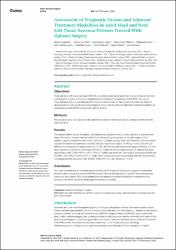| dc.contributor.author | Akagündüz, Baran | |
| dc.contributor.author | Akın Telli, Tuğba | |
| dc.contributor.author | Göksu, Sema Sezgin | |
| dc.contributor.author | Yıldırım, Hasan Çağrı | |
| dc.contributor.author | Özer, Muhammet | |
| dc.contributor.author | Göktaş Aydın, Sabin | |
| dc.contributor.author | Özyurt, Neslihan | |
| dc.contributor.author | Karacin, Cengiz | |
| dc.contributor.author | Paydaş, Semra | |
| dc.contributor.author | Doğan, Mutlu | |
| dc.date.accessioned | 2021-03-25T07:26:49Z | |
| dc.date.available | 2021-03-25T07:26:49Z | |
| dc.date.issued | 2021 | en_US |
| dc.identifier.citation | Akagündüz, B., Akın Telli, T., Göksu, S. S., Yıldırım, H. Ç., Özer, M., Göktaş Aydın, S. ... Doğan, M. (2021). Assessment of prognostic factors and adjuvant treatment modalities in adult head and neck soft tissue sarcoma patients treated with upfront surgery. Cureus, 13(2). https://dx.doi.org/10.7759/cureus.13324 | en_US |
| dc.identifier.issn | 2168-8184 | |
| dc.identifier.uri | https://dx.doi.org/10.7759/cureus.13324 | |
| dc.identifier.uri | https://hdl.handle.net/20.500.12511/6652 | |
| dc.description.abstract | ObjectivesHead and neck soft tissue sarcomas (HNSTSs) are a heterogeneous group of rare tumors. Surgical resection with negative margins remains the standard primary treatment for patients with HNSTS. The role of chemotherapy (CT) and radiotherapy (RT) remains controversial. In this multicenter study, we aimed to demonstrate the real-world assessing prognostic factors and the effect of adjuvant treatment modalities in adult patients with HNSTS treated with upfront surgery.MethodsWe included a total of 47 patients who underwent curative-intent resection of a primary HNSTS between 2000 and 2019.ResultsThe median follow-up was 29 months. The median age of patients was 51 years, and 66% of patients were male. The median relapse-free survival (RFS) of the study population was 31 months (range: 1.0-61.1 months), and the median overall survival (OS) was 115 months (range: 60.8-169.2 months). The univariable analysis revealed that treatment modalities showed a significant impact on RFS (p = 0.021); however, no difference was found in its impact on OS (p = 0.137). R0 resection did not showed impact on RFS (p = 0.130), but a significant association was found with OS (p = 0.004). In multivariable analysis, T stage of the tumor (hazard ratio [HR]: 3.834; 95% CI: 1.631-9.008; p = 0.002) and treatment with surgery and sequential RT and CT (HR: 0.115; 95% CI: 0.035-0.371; p < 0.001) were independent factors associated with RFS. R0 resection was independently associated with OS (HR: 4.902; 95% CI: 1.301-18.465; p = 0.019).ConclusionOur study revealed that R0 resection improved OS, and T3-4 stage of tumor was a negative independent factor for RFS in surgically resected HNSTS patients. The use of sequential CT and RT after resection was associated with a better RFS, which emphasizes the importance of multidisciplinary evaluation of the treatment of HNSTS. Randomized prospective studies are needed. | en_US |
| dc.language.iso | eng | en_US |
| dc.publisher | Cureus Inc. | en_US |
| dc.rights | info:eu-repo/semantics/openAccess | en_US |
| dc.rights | Attribution 4.0 International | * |
| dc.rights.uri | https://creativecommons.org/licenses/by/4.0/ | * |
| dc.subject | Survival Analysis | en_US |
| dc.subject | Head and Neck Sarcoma | en_US |
| dc.subject | Adjuvant Radiation Therapy | en_US |
| dc.subject | Head and Neck Cancer Surgery | en_US |
| dc.subject | Adjuvant Chemotherapy | en_US |
| dc.title | Assessment of prognostic factors and adjuvant treatment modalities in adult head and neck soft tissue sarcoma patients treated with upfront surgery | en_US |
| dc.type | article | en_US |
| dc.relation.ispartof | Cureus | en_US |
| dc.department | İstanbul Medipol Üniversitesi, Tıp Fakültesi, Dahili Tıp Bilimleri Bölümü, İç Hastalıkları Ana Bilim Dalı | en_US |
| dc.identifier.volume | 13 | en_US |
| dc.identifier.issue | 2 | en_US |
| dc.relation.publicationcategory | Makale - Uluslararası Hakemli Dergi - Kurum Öğretim Elemanı | en_US |
| dc.identifier.doi | 10.7759/cureus.13324 | en_US |



















